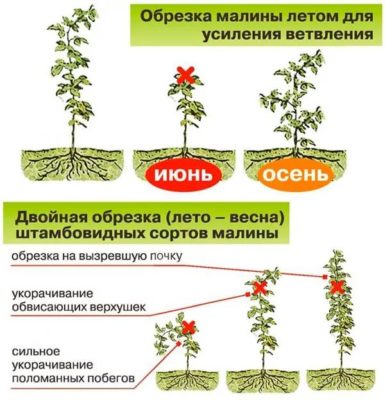How to pinch remontant raspberries in the summer and is this procedure necessary
There is a debate about the advisability of performing summer pinching of remontant raspberries. Some gardeners recommend not to neglect the procedure, which, in their opinion, increases the yield. Others do not see the point in pinching the tops of the shoots, since the remontant variety does not grow in breadth without it and gives a bountiful harvest from season to season. In this article, we will talk about the benefits of pinching raspberries and further caring for the bushes.
The content of the article
Do I need to pinch remontant raspberries in the summer
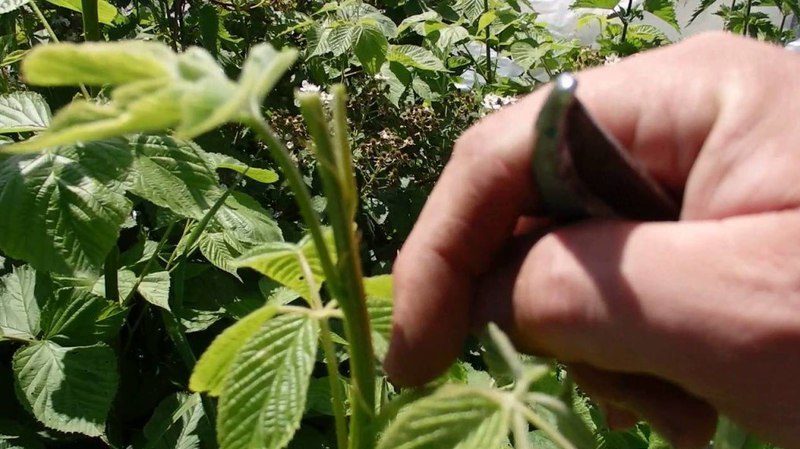
Repair raspberries are gaining popularity with gardeners, especially those who grow for sale. Its main advantage is twice a season fruiting. Subject to the rules of cultivation, the crop can be harvested until the end of October.
Repaired varieties are grown as annuals and are pruned completely at the end of the second wave of fruiting. In the spring, the shrubs grow with renewed vigor and quickly start up young shoots. Raspberry fruits are formed on the shoots of the current year.
If everything is clear with autumn pruning at the root, then gardeners' opinions differ about summer cutting of bushes. Some people prefer not to touch the shoots, arguing that they do not see much difference between the first and second wave of fruiting. Other gardeners advise to pinch only the tops of the shoots without applying trimming methodsthat are used in the cultivation of common raspberries.
Reference. Pinching of remontant raspberries is practiced mainly in southern Russia in order to slightly shift the timing of fruiting. Due to the summer heat, the fruits often burn in the sun and do not have time to fully ripen.
Features of pinching remontant raspberries
After pinching of the remontant varieties, the awakening of the buds and the growth of lateral shoots lasts up to 10 days... If you do not pinch, the central shoot will grow by more than 1 m. Pinching the top of the central conductor slows down the development of the plant. This procedure does not always have a beneficial effect on remontant raspberries. In some varieties, single fruits do not have time to ripen before the first autumn frosts.
Some varieties are prone to branching without pinching. On such bushes, lateral branching forms independently in the amount of 3-4 pieces. Varieties of Cascade Bryansk, Scarlet Sail, Novost Kuzmina, Kokinskaya, Modest nipping is not needed... For example, the Indian Summer variety needs to be pinched and gives up to 15 lateral shoots after the procedure.
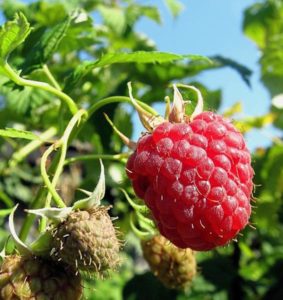
Repaired grade Progress late fruiting does not need to be pinched. Fruit branches, like bunches of grapes, grow on the tops of young replacement shoots. The total number of buds, inflorescences and fruits is 300-400 pieces. If you pinch, the clusters will not form. Instead of them, 2-3 lateral shoots will appear, which will bloom and tie some of the fruits, but they will not have time to ripen before the first frost. The bunches freeze out along with the branches, and in the future they have to be cut off.
The remaining young shoots grow low, and the summer raspberry yield decreases the following season. Experienced gardeners recommend plucking out about 50% of buds, inflorescences, fruits at the initial stage of formation. The remaining 50% of the fruit will grow large and sweet. Such a pinching helps to preserve the presentation of the fruit until the onset of the first autumn frosts.
There are non-tree-like groups of remontant raspberries, in which, on replacement shoots, the crop is located at the tops in the form of compact brushes (Progress) or fruit branches (Forest, Tachanka, Meteor, Crane, Lloyd George). You do not need to pinch these varieties.
Terms of the procedure
Pinching of remontant raspberries to increase yields is performed in May - June, depending on the region of cultivation. In the regions of the middle zone, the procedure begins in June, in the south - in May.
Auspicious days according to the lunar calendar in 2021:
- May - 2, 5, 6, 12-17, 20-23, 24-26;
- June - 1, 2, 6-8, 11-13, 16, 19-25, 29-30.
How to properly pinch remontant raspberries
Pinching the tops of a remontant raspberry is a simple procedure, but requires skill. The following inventory is used for work:
- garden shears (secateurs);
- rake for collecting shoots;
- medical alcohol 96%, kerosene, 3% solution of copper sulfate or potassium permanganate for disinfecting instruments.
Armed with a sharp tool, they cut off shoots that have reached 60-70 cm in height, or rather, pinch 20-25 cm tops. After this procedure, 3-4 lateral shoots are formed in the upper part of the bushes, and the stem itself coarsens. Pinching allows you to grow shrubs without the use of trellises, to increase the yield and fruit size due to lateral shoots.
Post-procedure care
Repaired raspberries are more demanding on lighting, heat, moisture, soil fertilization compared to conventional varieties. The increased need for nutrition is due to the high yield, which is 2-3 times higher than that of summer varieties.
Despite the fact that raspberries are a moisture-loving plant, caution should be exercised with respect to the remontant variety. Overflow and stagnation of moisture on the site should not be allowed. This leads to rotting of the rhizome and the death of small roots, due to which remontant raspberries reproduce.
Most demanded way of watering raspberries - sprinkling. Water is supplied from a hose with a spray nozzle or through sprinklers. Such watering is especially effective in the heat: branches, leaves, the ground around the bushes are completely wetted, the air humidity rises significantly. The only drawback is the high water consumption.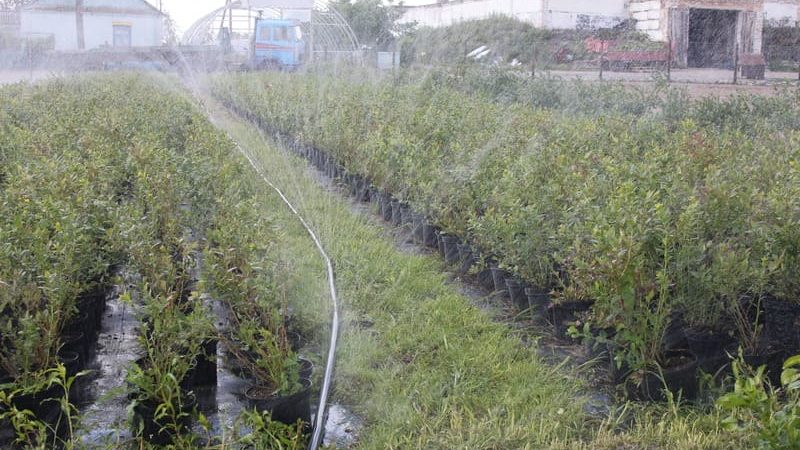
Many gardeners prefer the more economical method of irrigation - groove watering. Recesses up to 15 cm are dug around the bushes and water is fed into them from a bucket or hose. On raspberry plantations, it is convenient to use drip irrigation, which allows you to evenly moisturize the soil. An automated system for supplying water through pipes is installed on the site. The advantage of this method is that moisture is dosed to the roots.
The soil in the near-trunk circle is not loosened deeply - by 5-7 cm. To reduce the frequency of loosening, the site is mulched with peat or humus.
Council. Some of the ovaries must be removed, since the raspberries are not able to fully feed the fruits.
Repaired varieties are rarely attacked by insects and fungal infections. The secret lies in the fact that the life cycle pests adjusted to the life cycle of a common raspberry, which bears fruit in the second year after planting. Fungal infections of raspberries cannot fully develop on the bushes, since at the end of autumn the shoots of remontant raspberries are completely cut off along with spores of fungi and viruses. For the same reason, there is no need to take care of the wintering of plants.
During the period of fruit formation, the plant needs feeding potassium and phosphorus. The lack of these trace elements leads to inhibition of the growth of the bushes. With a deficiency of potassium, the leaves wrinkle and turn dark brown at the edges. With a phosphorus deficiency, the shoots grow long and thin, the leaves turn purple.
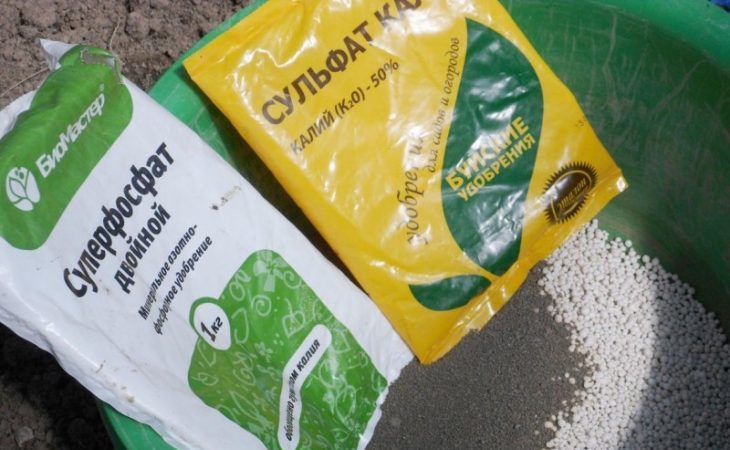
To maintain health and fruiting, improve the taste of fruits, raspberries are fertilized with foliar dressing "Kristalon" (10 g / 10 l). This increases the productivity of the crop by 30%, and the sugar content of the fruit by 3%.
For root dressing apply liquid fertilizers ("Ideal" - 30 ml / 10 l) or dry mixtures with potassium sulfate (30 g / m²), potassium magnesium (15 g), superphosphate (60 g)... Dry substances are scattered under the bush and water the soil with warm water.
In autumn, when digging into the ground, potassium and phosphorus (40 g of superphosphate, 20 g of potassium sulfate / m²) are embedded. On the eve of the first frost, water-charging irrigation is performed - 20 liters of water for each bush. The root zone is mulched with humus. After harvesting the second harvest the branches are completely cut off, leaving hemp no more than 5 cm high. In cold regions, the sites are covered with agrofibre or tarpaulin to protect the bushes from freezing.
Tips from experienced gardeners

Growing technology and care remontant raspberries do not differ much from conventional cultivars. However, experienced gardeners advise you to follow some rules in order to harvest a bountiful harvest from season to season:
- If you do not spend the autumn pruning of fruiting shoots, you can get a harvest from old shoots in early summer, and from new ones from August to October.
- Some gardeners prefer to harvest once a season, as they believe that old shoots squeeze strength from the plant at the beginning of the season, as a result of which it will not be possible to harvest a large crop in August. Nevertheless, remontant varieties are good because they make it possible to get 2 harvests per season.
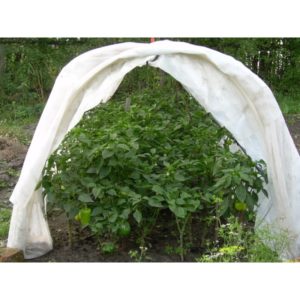 Harbor raspberries
Harbor raspberries - Repaired raspberries most of all need watering during flowering, formation and ripening of fruits. When watering, it is important to shed the soil 0.5 m deep.
- Weak growth must be completely removed during the season to prevent thickening of the plantings.
- The bushes will not spread in breadth if they are fertilized in summer with potassium-phosphorus fertilizers. Nitrogen-containing fertilizers are left in the spring.
- The roots of remontant raspberries continue to grow even at low temperatures, so the plantations are covered with non-woven fabric to protect the roots from freezing.
- Pruning of remontant varieties is performed after leaf fall, since the leaves support the growth of roots and the laying of buds of the new year.
Conclusion
Each gardener makes the decision to pinch remontant raspberries based on their own experience. Experienced summer residents are advised to be guided by trial and error, determining whether a procedure is needed for a particular variety or not.
Some varieties are prone to branching without pinching, side shoots are formed independently (varieties Kaskad Bryanskiy, Alyy Parus, Novost Kuzmina, Kokinskaya, Skromnitsa). At the same time, the Indian Summer cultivar needs a procedure for better branching. The pinching of remontant raspberries is practiced in the southern regions in order to shift the timing of fruiting. The procedure is performed in May. In colder regions, the pinching is carried out in June.
